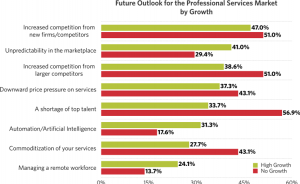Nearly 90% of agencies and 81% of marketers plan to expand their programmatic buying capabilities in 2018. Bringing this expertise in-house allows digital media teams to unify their data, their teams, and their buying, giving them a better handle on the complexities and, ultimately, allowing them to take back control.
The unanswered question: Are media teams built to handle the tools and the technology? Are they equipped with the digital knowledge to succeed?
As part of our research with Ad Perceptions, we took an in-depth look at the state of digital media teams including how they’re currently constructed and what needs to change as the digital landscape evolves.
Let’s take a step back …
Programmatic has given the ad industry an incredible amount of capabilities and efficiencies that weren’t possible even ten years ago, like automated and data-driven purchases of granular audiences at scale, real-time campaign optimization opportunities, and game-changing business insights. Not even a decade ago, for example, a media buyer would have to send 10 individual RFPs if they wanted their ads to run on 10 different sites – imagine trying to scale that process.
It sounds simple, but it’s come with a cost.
Programmatic has also led to more complexity, more confusion, more technology, and more platforms than ever before. It has increased cost structures in the form of programmatic teams, departments, trading desks, and companies. The digital space used to consist of limited vendor types, creatives, platforms, one device (desktop), buying methods, cost models, and tracking metrics. Those working in the industry know that’s no longer the case today.
Complexity has exploded. We’re inundated with thousands of vendors, and creative for formats that run the gamut (display, video, audio, social, and more). Running a campaign requires multiple platforms – many of which need their own unique login. This doesn’t include solving problems and piecing together communication and strategy over email, PDFs, and Excel spreadsheets. Not to mention all the different devices, buying methods, and cost types.
Programmatic Today
Managing all of this has become overwhelming and unbearable. How are teams currently managing the digital overload?
Today, agencies and marketers divvy their programmatic capabilities between various internal teams and outsourcing to external vendors. The preferred method depends on the business model. Marketer models are more diverse, according to our Ad Perceptions study. A significant portion of marketers surveyed (30%) prefer integrated internal teams. Compare this to 47% of agencies, which are less likely to outsource programmatic completely, and prefer instead to maintain specialized programmatic teams.
The amount of data sources and analytics tools being used on a day-to-day basis certainly doesn’t help. For campaigns, digital professionals are gathering data on search, ad serving, CRMs, social media monitoring, mobile and geo-location, syndicated media measurement, credit cards, and sales data. It’s a lot, and it should come as no surprise that 30% of agencies and 51% of marketers find it unmanageable.
Programmatic Tomorrow
How do we expect marketers and agencies to address this going forward?
Well, programmatic and direct buying aren’t going anywhere. So businesses must identify alternative and innovative solutions to differentiate their offering and remain competitive in the digital market – while also controlling costs.
The biggest shift over the next 12 months? Agencies and marketers plan to rely less on purely outsourcing models. And the majority of respondents indicated they plan to increase integrated programmatic and direct teams. Why outsource, the thinking goes, when instead you could equip your own teams and leverage your own expertise and take back control?
Want a more comprehensive look at the driving forces behind programmatic investment in 2018? Download the full report.
Digital & Social Articles on Business 2 Community(49)
Report Post






